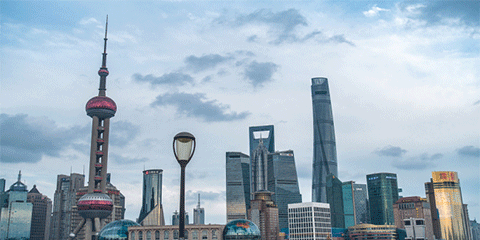How can China keep its momentum of development during trade war?
2018-08-20 1055
By CGTN Jiang Zheng
This year marks the 8th anniversary of China becoming the world's second-largest economy in 2010, when it took Japan's ranking in the world economy.

The Bund in Shanghai
Over the years, China has contributed tremendously to the global economy as the main driver of economic growth and international trade. Since 2005, China has on average accounted for one-third of the total global growth, according to IMF data. Between 2002 and 2016, China’s share in the total world exports increased from 7.2 percent to 17.0 percent and its share in the total world imports increased from 6.1 percent to 12.4 percent. It is now the largest country in terms of exports and the second largest country in terms of imports.
With all these achievements, nevertheless, it currently may not be the perfect time to celebrate. China's economy has shown various signs of slowing down, which has led many people to question the future prospective of the country's economic growth. Meanwhile, the escalating trade tensions with the US cast more shadows by making it even more worrisome.
How can China keep its momentum of development during the trade war? Instead of hastily looking ahead into the future, looking back may give us more guidance.
How did China make it from nothing to become the world’s second-largest economy? The cornerstone of China’s success can be simply yet precisely summarized by the concept of "reform and opening-up."
Through reform, people are allowed to compete freely and fairly, thrive and be rewarded. It means that the governments step back by removing unnecessary restrictions. It also means that the governments become more accommodating by promoting competition, innovation and hard work, and by keeping fairness.
As a result, private enterprises are emerging, growing and playing more significant roles. The state-owned enterprises are shrinking their share of the economy, but the remaining ones are stronger and more efficient. We have also seen that people are migrating for better working opportunities from the villages to the cities and from the central and west to the east.
Through opening-up, people are encouraged to learn from other countries. They are given the opportunity to benefit from participating in the global economy but also pushed to face the strongest competitors in the world. As a result, more advanced technology, and better production and management practices are adopted from other countries. More foreign direct investment is attracted, warmly hosted, and sometimes even treated far better than the domestic counterparts.
Then, after many years, we are the world’s second-largest economy. This thus leads us to answer the original question on dealing with the trade tensions and keeping the momentum of development. That is, the policy of reform and opening-up should be continuously adopted and more thoroughly implemented.
Among the long list, actions in the following areas could be more relevant, urgent, and effective. First, import tariffs and other types of barriers could be largely reduced and more foreign investment should be welcomed in previously restricted areas.
This can increase competition and ultimately improve consumer well-being. Second, more private investment and entrepreneurship should be encouraged in the service sector, especially in businesses related to education, health care, and elderly support.
This will greatly facilitate a rapid and yet more stable transition from an industrial economy to a service economy. And finally, the government can also promote population urbanization by further removing migration barriers and providing additional accommodations.
Source:CGTN



